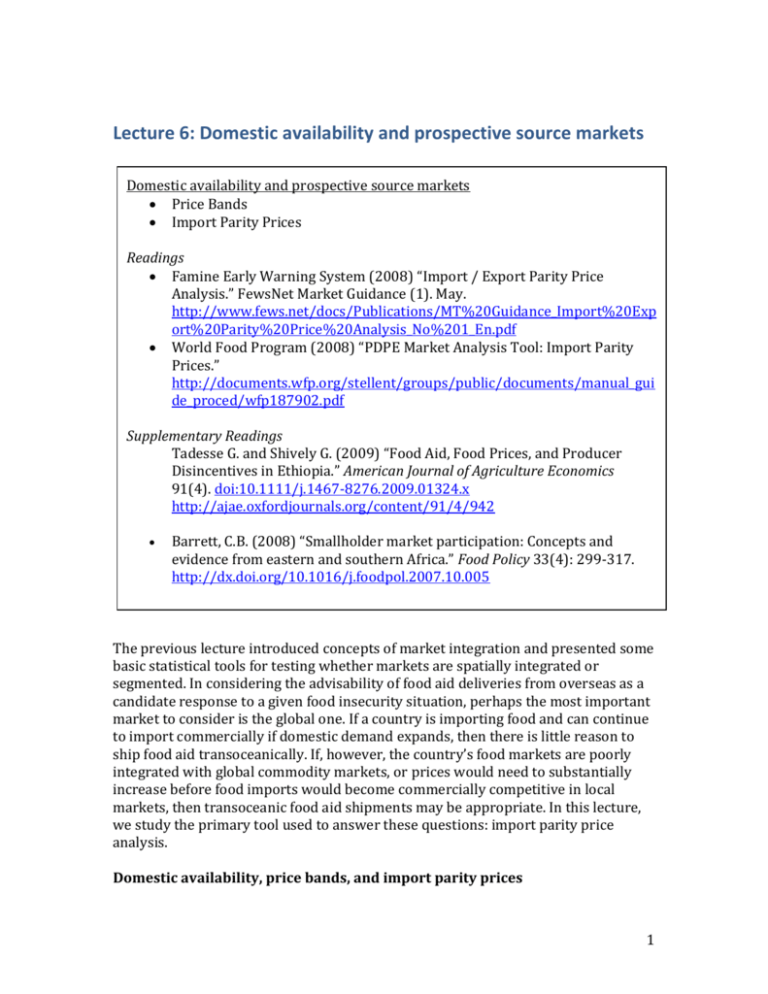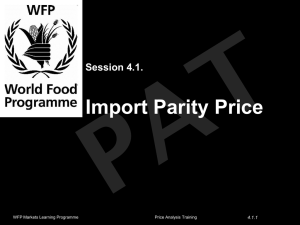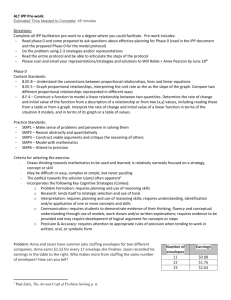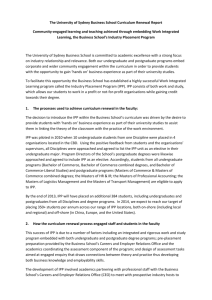Lecture 6: Domestic availability and prospective source markets
advertisement

Lecture 6: Domestic availability and prospective source markets Domestic availability and prospective source markets Price Bands Import Parity Prices Readings Famine Early Warning System (2008) “Import / Export Parity Price Analysis.” FewsNet Market Guidance (1). May. http://www.fews.net/docs/Publications/MT%20Guidance_Import%20Exp ort%20Parity%20Price%20Analysis_No%201_En.pdf World Food Program (2008) “PDPE Market Analysis Tool: Import Parity Prices.” http://documents.wfp.org/stellent/groups/public/documents/manual_gui de_proced/wfp187902.pdf Supplementary Readings Tadesse G. and Shively G. (2009) “Food Aid, Food Prices, and Producer Disincentives in Ethiopia.” American Journal of Agriculture Economics 91(4). doi:10.1111/j.1467-8276.2009.01324.x http://ajae.oxfordjournals.org/content/91/4/942 Barrett, C.B. (2008) “Smallholder market participation: Concepts and evidence from eastern and southern Africa.” Food Policy 33(4): 299-317. http://dx.doi.org/10.1016/j.foodpol.2007.10.005 The previous lecture introduced concepts of market integration and presented some basic statistical tools for testing whether markets are spatially integrated or segmented. In considering the advisability of food aid deliveries from overseas as a candidate response to a given food insecurity situation, perhaps the most important market to consider is the global one. If a country is importing food and can continue to import commercially if domestic demand expands, then there is little reason to ship food aid transoceanically. If, however, the country’s food markets are poorly integrated with global commodity markets, or prices would need to substantially increase before food imports would become commercially competitive in local markets, then transoceanic food aid shipments may be appropriate. In this lecture, we study the primary tool used to answer these questions: import parity price analysis. Domestic availability, price bands, and import parity prices 1 This lecture focuses on market integration tools/analytics related to the following MIFIRA sub-questions: 2a. Where are viable prospective source markets? Local purchases – i.e., procurement within the country in which food is to be distributed – makes sense when adequate local supplies exist in markets not well integrated with the distribution market. When the domestic economy is well integrated with the global economy, commercial imports into well-integrated domestic markets – which might not include the target distribution market – provide a vehicle to replenish domestic supplies without fuelling food price inflation. Knowing the relationship between domestic and international prices is essential to identifying appropriate source markets. 2b. Will agency purchases drive up food prices excessively in source markets? If domestic prices are well below import parity prices, domestic procurement can be expected to drive up prices in the procurement market. Otherwise, the prospect of commercial imports can effectively cap prospective price increases in source markets. 2c. Will local or regional purchases affect producer prices differently than transoceanic shipments? If domestic prices are below import parity prices, domestic procurement can be expected to drive up prices in the procurement market, benefitting producers and traders. Transoceanic shipments, by contrast, tend to expand supply, driving down producers prices unless they are at export parity price already, in which case transoceanic food aid shipments will tend to increase commercial food exports by displacing domestic demand. Price Bands As Barrett (2008 Food Policy) explains, households might participate actively in a local market and yet not be integrated into the global market. This case is depicted in the accompanying figure, which depicts the commodity price at the border (the IPP, pcb), the associated price band for the local market, which is defined as pcb, and the commodity-specific spatial intermarket transactions cost, tc(G,Q). In the present case, the price band fully encompasses the local market autarkic price, pcm, indicating the local market is segmented from the global market. Within the local market, household-specific supply curves (S(Aj) and S(Ak)), a common household demand curve D for two stylized households, the former a local net buyer, the other a local net seller, and household-and-commodity-specific transactions costs c(Z,Ai,G,W,NSc) combine with the local market autarkic price, pcm, to create a household-specific price band that defines each household’s market participation pattern (net seller, net buyer or autarkic) and its resulting effective price, pc*i. This figure illustrates that just because there is market trade doesn’t mean people are integrated into the global market for the traded commodity. 2 Source: Barrett (2008), Food Policy Indeed, this finding of local market participation with market segmentation leads to a generalization of the net benefit ratio we discussed earlier. As Barrett (2008 Food Policy) explains, the welfare elasticity with respect to a rise in the IPP, , is equal to: 𝑝𝑐∗ 𝑀 β≡[ ] ∙ (𝜕𝑝𝑐𝑚 /𝜕𝑝𝑐𝑏 ) ∙ (𝜕𝑝𝑐∗ /𝜕𝑝𝑐𝑚 ). Y∗ Note that the welfare elasticity with respect to a rise in IPP is a function not just of the net sales position of the household with respect to the commodity in question (the portion in brackets), but also of the price transmission from IPP to the local market price (𝜕𝑝𝑐𝑚 /𝜕𝑝𝑐𝑏 ) and the price transmission from the local market to the household (𝜕𝑝𝑐∗ /𝜕𝑝𝑐𝑚 ). The equation collapses to the standard Deaton-style net benefit ratio only when the law of one price holds in both stages so that IPP price changes transmit one-for-one to the household, a condition that rarely holds in remote rural areas. Import parity price The import parity price (IPP) is the price of imported goods at the national market hub (usually the capital city or major commercial port of entry). This is the global market price delivered to the country, usually reflected in import prices (CIF, or including “cost, insurance and freight”), as recorded in balance of payments or 3 customs statistics by the relevant national ministry or statistical agency, plus any tariffs assessed on imports of that commodity. Sometimes import parity price series are available directly from publicly accessible government data or donor or local research organizations. More commonly, one has to construct IPP series from secondary data series or interviews with importers or NGO or WFP offices that procure aid regionally. In principle, the import parity price sets an anchor price from the global market under the principle that the destination country market is small relative to the global market and thus is a price-taker (i.e., faces perfectly elastic supply) on the international market. Therefore, as we discussed in the previous lecture on market integration, prices in local markets that are well-integrated with the national hub market should not rise above the IPP plus the domestic cost of moving commodity to the local market. What are the implications for response analysis? If IPP plus costs to local market is equal to or less than the local market price, then traders have a commercial incentive to import unless restricted by government or by financial or logistical bottlenecks. The IPP plus costs to local market should set an upper bound on prices in the local market, limiting prospective price increases due to cash or voucher distribution. Keep in mind, however, that where transport costs are high (from global markets to the national hub market, and/or from the national hub market to the local market), the upper bound on local prices created by the IPP can be high, even in perfectly competitive and well-functioning markets. Conversely, if IPP plus the costs to move a commodity to the local market significantly exceed the local market price, that indicates lack of integration with the global market. Under prevailing prices, traders have no incentive to import food commercially. This could be because the country has abundant food supplies that keep domestic prices relatively low, in which case there may be local markets that would make good sources for local food procurement. Or it could be because of administrative, financial or logistical barriers to importing that result in the peculiar combination of low prices and scarcity, in which case regional food procurement is typically the best response if food deliveries are needed per the analysis of MIFIRA question 1. When local prices are higher than IPPs, it is lower cost to buy imported food from other countries relative to buying food locally. As reported by Tschirley and del Castillo (2006), for cost efficiency reasons, the World Food Programme switches away from local procurement when local prices exceed import parity. In other words, the WFP procures locally when domestic prices are below the IPP. Thus, the IPP is a valuable tool for analysts considering whether to procure locally or regionally, especially when budgets are limited. Calculating IPPs 4 The IPP is calculated as the sum of the world market price for the commodity (usually quoted in FOB – “free on board” – terms at a major export port/market), plus ocean freight and insurance costs from the export market to the local port, both of which are typically quoted in international currency terms (typically US dollars), plus any applicable tariffs (usually quoted in the domestic currency). Note that this computation will typically require conversion using exchange rate series and that one must establish whether the relevant tariff(s), if any, are ad valorem (i.e., proportional, a fixed percentage on top of the CIF – “cost, insurance and freight” – import price) or specific (i.e., a fixed currency amount per physical unit imported, irrespective of the prevailing price). International commodity price series are available from various sources, such as the International Monetary Fund’s International Financial Statistics’ (IMF IFS) commodity price series (http://www.imfstatistics.org/imf/) and the World Bank’s commodity price “pink sheet” (http://econ.worldbank.org/WBSITE/EXTERNAL/EXTDEC/EXTDECPROSPECTS/0,, contentMDK:21148472~menuPK:556802~pagePK:64165401~piPK:64165026~th eSitePK:476883,00.html). The IMF IFS also reports exchange rates. The Baltic Exchange is perhaps the best public source of ocean freight rate information (http://www.balticexchange.com/). Tariff data are typically available from government trade ministries, although some foreign embassy’s agricultural attaché offices publish the relevant rates (e.g., the US Department of Agriculture’s Global Agricultural Information Network, http://gain.fas.usda.gov/Pages/Default.aspx). National statistical services and central banks commonly report (i) national consumer price indices, often including disaggregated data on elements of the market basket (e.g., staple foods prices) and fuel prices (important to establishing the costs of commerce between spatially distinct markets), and (ii) price series across different, spatially-distinct markets over time. Ministries of Agriculture often have food price data series available. Note that sometimes the local product and the imported product are not directly comparable (e.g., palm oil produced domestically versus imported vegetable oil). In such cases, there is necessarily some added noise in comparison between series. Analyzing IPPs Having computed the IPP, one typically wants to plot the hub market wholesale price series for the same commodity against the IPP. Visual examination of these series should clearly indicate whether domestic market prices are higher than, equal to or less than the IPP. If one can obtain and plot commercial import volumes as well, a clear picture rapidly emerges of whether commercial imports are responding to movements in domestic wholesale prices relative to IPP as one would expect. The absence of such movements is often a signal of some sort of government, financial or logistical bottleneck impeding cross-border commercial trade. Below is a very nice example of such a plot, in this case for Bangladesh, reflecting clearly the country’s (very successful) reliance on commercial rice imports to address local production 5 shortfalls and price increases caused by serious flooding in 1998. Price increased to the IPP, then basically remained there as import volumes jumped to meet sudden shortfalls in domestic supply. Once the next (quite good) harvest came in April-June 1999, local wholesale prices settled back beneath the IPP again and commercial import volumes receded markedly. One can move beyond these simple visual comparisons and compute the same sorts of statistics to test the degree of market integration between the domestic market (represented by the main hub market wholesale price) and the global market (represented by the IPP). Such statistics offer a clearer test of the strength of price comovement between domestic and global markets. Limitations of the IPP IPPs become less useful when there is/are: - significant non-tariff barriers (e.g., quotas, bans on genetically modified or other types of food commodities, other sanitary and phytosanitary standards that effectively keep out certain food imports, etc.) - not free and open competition among importers or on the domestic wholesale market (e.g., due to restrictive government licensing) - binding foreign exchange restrictions such that a black market exists in the currency, leading to divergence between official and black market exchange rates. 6 The IPP is also most relevant to the main domestic wholesale market. Smaller, more remote markets are often not well-integrated with the main wholesale market, due to the existence of price bands and due to lack of market integration. Summary The import parity price is a very handy metric for gauging the degree to which the main domestic wholesale market is well-integrated with global commodity markets so that one can reasonably expect local traders to use commercial imports to meet any demand expansion induced by food security interventions and whether this is likely to entail significant price rises. If domestic markets are well-integrated with the international market, the IPP sets the upper price bound on domestic wholesale prices and then commercial import volumes adjust to address any excess demand that might emerge. In such cases, cash and voucher distribution commonly makes sense. By contrast, when domestic wholesale market prices lie well below the IPP, or when they do not seem to track the IPP even when they are at or above that level, one should be cautious about cash or voucher distribution programs. When domestic wholesale prices are well below IPP, local or regional procurement may be appropriate where direct food distribution seems advisable. 7









